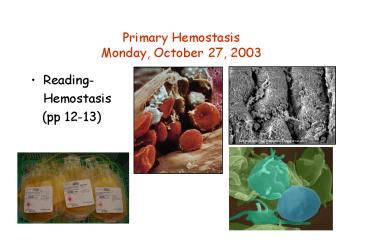Primary Hemostasis Monday, October 27, 2003 - PowerPoint PPT Presentation
1 / 25
Title:
Primary Hemostasis Monday, October 27, 2003
Description:
Primary Hemostasis Monday, October 27, 2003 Reading-Hemostasis (pp 12-13) Thrombopoiesis Primary Hemostasis Monday, October 27, 2003 Thrombopoiesis Introduction to ... – PowerPoint PPT presentation
Number of Views:399
Avg rating:3.0/5.0
Title: Primary Hemostasis Monday, October 27, 2003
1
Primary HemostasisMonday, October 27, 2003
- Reading-
- Hemostasis
- (pp 12-13)
2
Introduction to Hemostasis
The hemostatic system helps to ensure that blood
is confined to, and flows freely within the
circulatory system. Hemorrhage, intravascular
thrombosis, and embolism are common clinical
manifestations of many diseases. The normal
hemostatic system limits blood loss by precisely
regulated interactions between components of the
vessel wall, circulating blood platelets, and
plasma proteins. When disease or trauma
damage large vessels, bleeding may occur, despite
a normal hemostatic system. Hemorrhage is also
caused by an inherited or acquired disorder of
the hemostatic machinery itself.
3
The Arrest of Bleeding
Mechanisms underlying the arrest of bleeding are
2-fold --vasoconstriction (narrowing of blood
vessels) to help prevent further blood
loss --formation of a hemostatic plug (a
"thrombus or clot") derived from platelets and
fibrin strands, in which RBC's/WBC's are trapped.
4
Definition of Hemostasis
Hemostasis is defined as the process that
maintains the flowing blood in a fluid state and
confined to the circulatory system. The
hemostatic mechanism is not a single biological
pathway, but the product of the complex
interactions of a number of distinct
systems --vascular system --blood
platelets --blood coagulation
system --fibrinolytic system --inhibitors
of the above systems.
5
Definition of Hemostasis (contd)
Accurate diagnosis and treatment of patients
with either bleeding or thrombosis requires some
knowledge of the pathophysiology of hemostasis.
Divided into primary and secondary
components and is initiated when trauma/surgery,
or diseases disrupt the vascular endothelial
lining and blood is exposed to subendothelial
connective tissue.
6
Vascular System
Blood circulatory system is divided into 3
separate subsystems Systemic circulation
delivery of oxygenated arterial blood from the
left ventricle to the body tissues and return of
deoxygenated venous blood to the right
atrium. Pulmonary circulation delivery of
deoxygenated blood from the right ventricle to
the lungs and the return of the oxygenated blood
to the left atrium.
7
Vascular System (contd)
Portal blood systems act as venous conduits
transporting substances (e.g., nutrients and
hormones) from various sites --largest portal
system is the hepatic portal system that connects
the intestine and spleen to the hepatic
sinusoids. --sinusoids drain into the hepatic
veins and from there into the vena cava that
carries blood directly to the heart.
8
Systemic and Pulmonary Circulatory Systems
9
Components of Hemostasis
Blood vessels --designed for smooth movement
of blood from the heart to the tissues and
back. --considered to be an anticoagulant
surface, to prevent a clot from forming on their
surface. Platelets --help maintain the
integrity of the vessel lining, and they 'plug'
any rupture in the circulatory vessels.
10
Components of Hemostasis (contd)
Plasma proteins --soluble circulating blood
proteins function in the proper maintenance of
hemostasis. By definition --primary
hemostasis is the role of vessel wall
(endothelial cells) and platelets and
--secondary hemostasis is the process of blood
coagulation involving proteins and other
cofactors.
11
Comparison of Blood Vessels
12
Wall Structures of Veins, Arteries, Arterioles
and Capillaries
13
Wall Structures of Veins, Arteries, Arterioles
and Capillaries
14
Vascular Endothelium Function
Vasodilation, inhibition of platelet
aggregation From platelets, muscular arteries
constrict Cytokines induce synthesis to promote
leukocyte adhesion Promote platelet-collagen
adhesion to exposed sub-endothelium
15
Vascular Endothelium Function
Anticoagulant- Inhibits coagulation extrinsic
pathway Anticoagulant- Inhibits coagulation by
activating protein C system Anticoagulant-
Inhibits coagulation by activating
fibrinolysis Anticoagulant- Inhibits coagulation
by activating antithrombin Procoagulant-
Inflammatory cytokines (IL-1, TNF) induce
expression
Tissue factor pathway inhibitor Thrombomodulin
Tissue plasminogen activator Heparan sulfate
proteoglycans Tissue factor
16
Blood Platelets
Platelets are formed from the cytoplasm of bone
marrow megakaryocytes and are the smallest of the
blood cells. Normal platelet count lies
between 150-400 x 109/L Disc-shaped,
anucleated cells with complex internal structure
reflecting the specific hemostatic functions of
the platelet.
17
Blood Platelets (contd)
Two major types of intracellular
granules --a-granules contain coagulation
factors (fibrinogen, von Willebrand Factor, and
coagulation factors V and VIII) and
platelet-derived growth factor (PDGF). --dense
granules (because of their appearance on EM)
contain ADP, ATP and serotonin. a- and dense
granules contents released by platelet activation.
18
Development and Maturtation of a Megakaryocyte
19
Thrombopoiesis
20
(No Transcript)
21
Platelet Function
Tissue Injury Platelet Adhesion Platelet shape
change Platelet aggregation Secretion Primary
hemostatic plug
During primary hemostasis, platelets display 4
properties --adhesion to a surface --shape
change --release of granule content --aggregation
22
Platelet Function (contd)
Effective primary hemostasis requires three
critical events--platelet adhesion, granule
release, and platelet aggregation. Within a
few seconds of injury, platelets adhere to
collagen fibrils in vascular subendothelium via a
specific platelet collagen receptor.
23
Platelet Function and Aspirin
Aspirin is the best characterized of the many
drugs that alter platelet function -aspirin
irreversibly inactivates the enzyme
cyclooxygenase -prevents production of
thromboxane A2 from arachidonic acid, and this
inhibits aggregation for the life-time of the
platelet.
24
(No Transcript)
25
Phases of Hemostasis
Primary Secondary
Platelet-mediated Fibrin-formation End
othelial cell-mediated mediated Results in
clinicians obtaining a clinical history using a
two-compartment classification system --primar
y defects result in immediate bleeding --secon
dary defects cause delayed bleeding.































